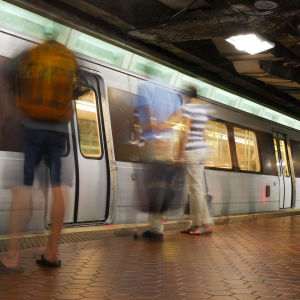Across the country, sit-down restaurants and bars have been ordered to close.
National parks are shut down. Tens of thousands of small businesses are on the verge of bankruptcy. All of these restrictions are supposed to be for our own good.
So why are public transit systems still running buses and trains?
A recent study found that New York City subways were “a major disseminator — if not the principal transmission vehicle — of coronavirus infection.” It’s no coincidence that 45 percent of all transit travel in the United States during the first two months of 2020 was in the New York-northern New Jersey urban area, and 45 percent of all coronavirus deaths have also been in that area.
But we didn’t have to wait for that study: A 2018 study found that “mass transportation systems offer an effective way of accelerating the spread of infectious diseases,” while a 2011 study found that people who use mass transit were nearly six times more likely to have acute respiratory infections than those who don’t.
Transit agencies say they are helping “essential workers” conduct their business. But if they are so essential, wouldn’t it be better to make sure they have a safe way of getting to work? If we cared about people’s safety, then transit agencies should have shut down at the same time we closed other non-essential businesses and asked people to stay at home.
Instead of shutting down when the recent pandemic hit, transit agencies demanded that Congress give them $25 billion so they can continue spreading disease during the pandemic. Congress agreed to this without any debate.
Effectively, Congress rewarded the agencies for spreading disease. It would have been better to use that money to help transit-dependent essential workers buy a car so they could have a safe way of getting to work.
The problem is that the transit lobby has successfully made public transit a sacred cow that politicians fund without almost no questions asked. Yet data published by the federal government reveal that most of the claims transit advocates make for public transit are wrong.
Transit is supposedly greener than driving, yet Department of Energy data show that transit uses more energy per passenger mile than the average SUV, and much more than the average car.
Transit is supposedly vital for getting low-income people to work, yet Census Bureau data show that the people most likely to use transit are those who earn more than $75,000 a year.
Transit supposedly deserves subsidies because highways are subsidized. Yet Department of Transportation data indicate that subsidies to driving average about a penny per passenger mile while subsidies to transit average $1.01 per passenger mile.
The coronavirus is one of several black swans — unexpected events that shock the economy — that have taken place in the last two decades. Others include 9/11, Hurricane Katrina, and the 2008 financial crisis.
All of these events have demonstrated that we need a resilient transportation system, one that is relatively immune from terrorist attacks; protects its users from infectious diseases; helps people flee and recover from natural disasters; and isn’t crippled by a loss of revenues during recessions and depressions.
That system is not public transit, which has been a target for terrorists, a spreader of diseases, has proven helpless in the face of hurricanes and other disasters, and suffers a financial crisis in every recession. Most people intuitively understand this, which is why transit ridership has declined in each of the last five years despite increasing subsidies.
It is time to shut down transit agencies now before they can spread COVID-19 any further.
Then we will need to have a serious debate about how to make our transportation system as resilient as possible when the pandemic is over.

